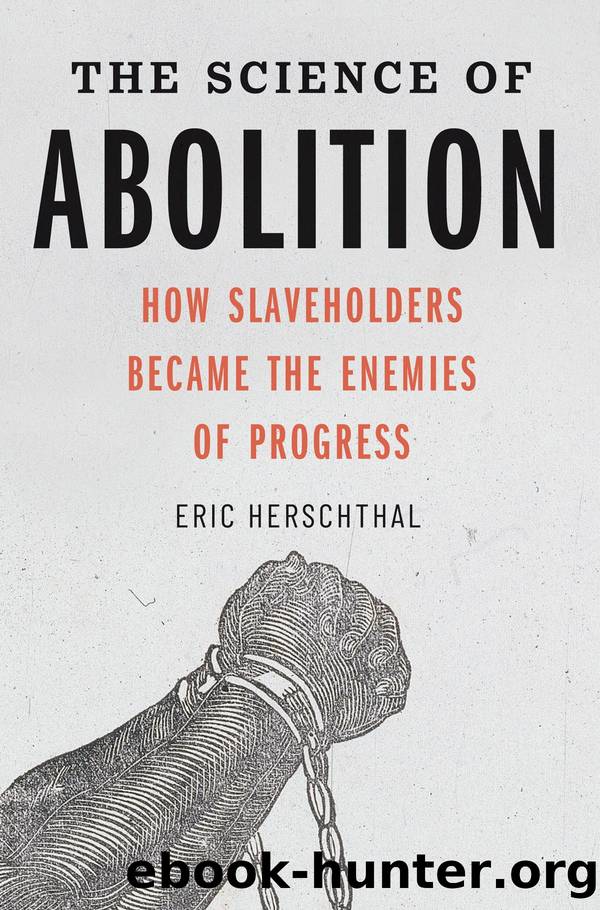The Science of Abolition: How Slaveholders Became the Enemies of Progress by Eric Herschthal

Author:Eric Herschthal
Language: eng
Format: epub
Publisher: Yale University Press
Map of Southeast Asia.
Designed by Gerry Krieg.
Much as Britainâs abolitionist elites contributed to the colonization of Africa, they played a similar role in the East Indies. Abolitionists were particularly vital to the colonization of modern-day Indonesia, Singapore, and Malaysiaâpart of an archipelago anchored halfway between Australia and India that came under British control in the 1810s. Elite abolitionists hoped that these regions could, like Sierra Leone, become an alternative location for free-labor plantationsâonce, that is, the regionâs indigenous form of slavery was eradicated. The challenge for abolitionists was to limit the damage that public knowledge of a preexisting form of slavery might do to their cause. In this regard, men of science stationed in the East Indies became exceedingly helpfulâno one more so than Thomas Stamford Raffles, a botanist, colonial official, and antislavery advocate.33
The British East India Company named Raffles its lieutenant governor of Java in 1811, the year the company took control of the island from the Dutch and became Britainâs de facto government. Raffles held the position for six years, and though the British exchanged Java for other East Indian settlements in 1817, the scientific research he conducted on the island, and the antiâslave trade measures he enacted while there, became touchstones for abolitionists throughout the 1820s. In 1817 Raffles published a natural history of Java that included a robust defense of Britainâs humanitarian policiesâabolishing slavery above allâand in turn made Britainâs presence in the region seem less like a colonization project and more like a humanitarian intervention. In the text, titled A History of Java, Raffles wrote that his mission as lieutenant governor was âto uphold the weak, to put down lawless forces, to lighten the chain of the slave,â and to promote âhumane institutions.â When touting the antislavery reforms he enacted while governing, he thanked abolitionists for their support: his own antislavery policy, he wrote, âtook for its basis the principles of the African Institution.â Raffles in fact worked closely with London abolitionists. In a private 1819 letter to Wilberforce, an AI founder, Raffles reiterated his support for âthe cause of the slave,â and in another letter he described how the spread of Islam in the region seemed to extend slaveryâs reachââMay not therefore the spread of the Gospel go hand in hand with the Abolition of the slave trade?â When Raffles returned to London in 1824, Wilberforce, Raffles, and their wives, Sophia Raffles and Barbara Wilberforce, spent many evenings together, and Wilberforce continued to praise Rafflesâs âpublic spirit & Philanthropyâ in their private letters.34
To be sure, Raffles often exaggerated his antislavery accomplishments. When he arrived in Batavia, the capital of Java, in 1811, he discovered a massive slave system. In 1814, the nearest date when numbers are available, there were 14,239 enslaved people in the city, which had a total population of 47,217. Ten years later, in 1824, the cityâs enslaved population had declined by 1,753, partly on account of Rafflesâs reforms, which included an annual tax on all enslaved people over the age of eight, a complete slave-trade ban, and a registry for all enslaved people on the island.
Download
This site does not store any files on its server. We only index and link to content provided by other sites. Please contact the content providers to delete copyright contents if any and email us, we'll remove relevant links or contents immediately.
| Anthropology | Archaeology |
| Philosophy | Politics & Government |
| Social Sciences | Sociology |
| Women's Studies |
The Leavers by Lisa Ko(6472)
Born to Run: by Christopher McDougall(6260)
iGen by Jean M. Twenge(4702)
Sapiens by Yuval Noah Harari(4537)
The Kite Runner by Khaled Hosseini(4433)
Spare by Prince Harry The Duke of Sussex(4195)
Bullshit Jobs by David Graeber(3179)
Livewired by David Eagleman(3121)
Goodbye Paradise(2961)
Never by Ken Follett(2880)
A Dictionary of Sociology by Unknown(2518)
Harry Potter 4 - Harry Potter and The Goblet of Fire by J.K.Rowling(2416)
The Club by A.L. Brooks(2360)
People of the Earth: An Introduction to World Prehistory by Dr. Brian Fagan & Nadia Durrani(2346)
The Social Psychology of Inequality by Unknown(2310)
Machine Learning at Scale with H2O by Gregory Keys | David Whiting(2289)
Harry Potter and the Order of the Phoenix (5) by J.K. Rowling(2227)
0041152001443424520 .pdf by Unknown(2220)
Don't Sleep, There Are Snakes by Daniel L. Everett(2216)
